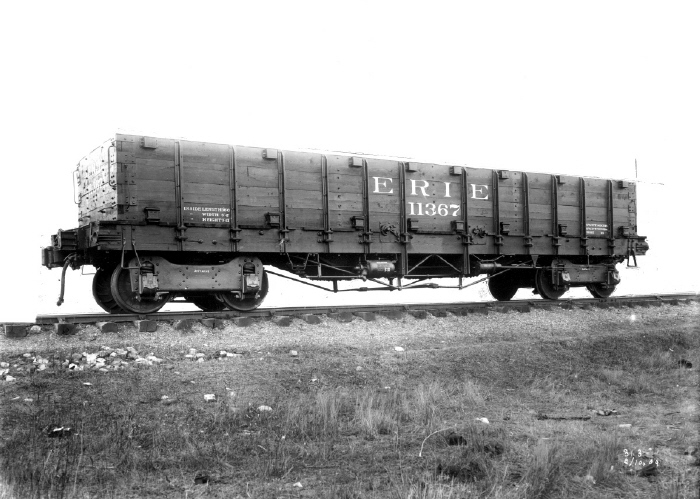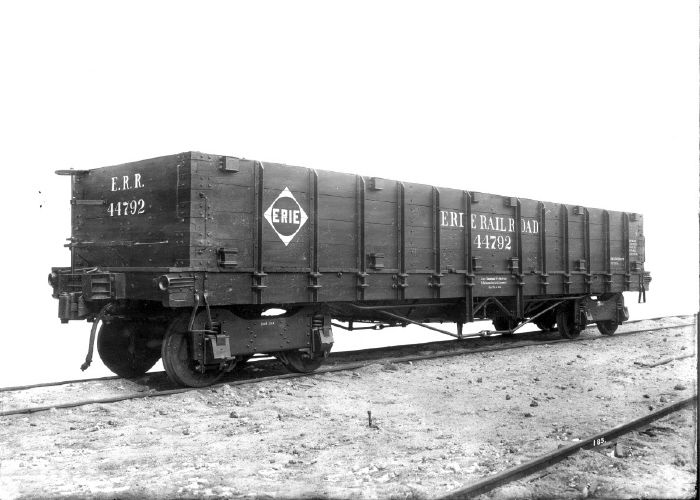Introduction
The Ralston Steel Car Company not only designed and built all-steel cars,
they also reconditioned older cars applying steel underframes and other
steel fixtures. Examples of these are shown in this group of 6 Erie
cars. These cars exemplify some changes in freight car design and
construction from wood cars of the late 19th century to all
steel cars of the early 20th century.
The photographs are from the B. J. Kern collection. Photo processing and
research by William Johnson Sources for the technical and historical
information given in the captions below are the 1913 edition of the
Official Equipment Register and The American Railroad Freight Car
by John H. White, Jr., published by John Hopkins University Press, 1993.
Click on the photos to enlarge

Erie 11367
The 1913 edition of the equipment register classifies this as a "twin
hopper bottom gondola" in the car number series 11000 – 15999. A note in
the register indicates that some of the cars in this number series were
initialed Chicago & Erie R.R. The date when this car was newly built is
unknown. This is a wood car with steel hoppers possibly added by
Ralston. This car has the cast iron or steel "dead blocks" on either side
of the coupler to help absorb impacts from hard couplings. The photograph
is dated 2-15-09

Erie 11367
This
is a side view of the same car. The photograph is dated 2-10-09.
Erie 44792
The 1913 edition
of the equipment register classifies this as a "twin hopper bottom
gondola" in the car number series 44000 – 48999. This photograph shows
the condition of the car upon arrival at Ralston for reconditioning. This
car also has the cast iron or steel "dead blocks" on the car end sill.
The photograph is dated 12-0-09.

Erie 44792
This
photograph shows the same car after reconditioning and the application of
a steel underframe. A stencil on the car says "Steel Underframe Mfd and
Applied By the Ralston Steel Car Co. Columbus, O. Patd. Dec. 19 1905." The
date of the photograph is unknown, but based on the numbering scheme used
by the photographer, this would have been taken in December, 1907 or
January, 1908.

Erie 44262
The
1913 equipment register classifies this as a "twin hopper bottom gondola"
in the car number series 44000 – 48999. Judging from the appearance of
the interior of the car, it has arrived Ralston for reconditioning and
probably the application of a steel underframe and steel hoppers. Note
the wooden "dead blocks" on this car. Dates for the original construction
of the car and the photograph are unknown.

Erie 45899
The
1913 equipment register classifies this as a "twin hopper bottom gondola"
in the car number series 44000 – 48999. This car also appears to have
arrived at Ralston for reconditioning and the probable application of a
steel underframe and steel hoppers. This car has the cast iron or steel
"dead blocks" applied. The date of the photograph is unknown.

Erie 16578
The
1913 edition of the equipment register classifies this as a "drop end
gondola" in the car number series 16000 – 17999. It appears that Ralston
reconditioned the car and applied a steel underframe. The car is
constructed of wooden ends and sides. This car also has two cast iron or
possibly steel "dead blocks" on either side of the coupler. What may
appear as silver and black "striping" on the car's side braces are the
effect of raking sunlight, and shadows cast by the adjacent stake
pockets. The photograph is dated 3-20-07.

Erie 41301
The
1913 equipment register classifies this car as a "triple hopper bottom
gondola" in the car number series 41000 – 41999. This is a new,
all-steel car built 1-24-12. A prominent stencil on the side of the car
indicates that it complies with the United States Safety Appliance
Standards which were enacted in 1893 and made effective in 1900. These
new standards mandated modernized air brakes, couplers, and
miscellaneous appliances such as handholds. Note the horizontal
handholds and more substantial foot stirrups compared with the vertical
handholds and "homemade" shape of the stirrups on the wood cars. Also
note the absence of "dead blocks" on the end of the car indicating a
more shock absorbent coupler and draft gear arrangement. The date of
the photograph is unknown.